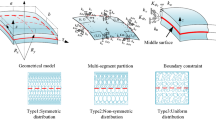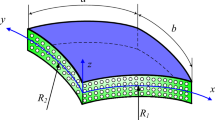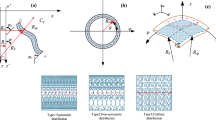Abstract
This study uses iso-geometric investigation, which is based on the non-uniform rational B-splines (NURBS) basis function, to investigate natural oscillation of bi-directional functionally graded porous (BFGP) doubly-curved shallow microshells placed on Pasternak foundations with any boundary conditions. The characteristics of the present material vary in both thickness and axial directions along the x-axis. To be more specific, a material length-scale coefficient of the microshell varies in both thickness and length directions as the material’s mechanical properties. One is able to develop a differential equation system with varying coefficients that regulate the motion of BFGP double-curved shallow microshells by using Hamilton principle, Kirchhoff–Love hypothesis, and modified couple stress theory. The numerical findings are reported for thin microshells that are spherical, cylindrical, and hyperbolic paraboloidal, with a variety of planforms, including rectangles and circles. The validity and effectiveness of the established model are shown by comparing the numerical results given by the proposed formulations with previously published findings in many specific circumstances. In addition, influences of length scale parameters, power-law indexes, thickness-to-side ratio, and radius ratio on natural oscillation responses of BFGP microshells are investigated in detail.
Similar content being viewed by others
References
Calladine C R. Theory of Shell Structures. Cambridge: Cambridge University, 1983
Pietraszkiewicz W, Konopinska V. Junctions in shell structures: A review. Thin-walled Structures, 2015, 95: 310–334
Nguyen V P, Anitescu C, Bordas S P A, Rabczuk T. Isogeometric analysis: An overview and computer implementation aspects. Mathematics and Computers in Simulation, 2015, 117: 89–116
Jüttler B, Langer U, Mantzaflaris A, Moore S E, Zulehner W. Geometry + simulation modules: implementing isogeometric analysis. Proceedings in Applied Mathematics and Mechanics, 2014, 14(1): 961–962
Marussig B, Hughes T J R. A review of trimming in isogeometric analysis: Challenges, data exchange and simulation aspects. Archives of Computational Methods in Engineering, 2018, 25(4): 1059–1127
Hughes T J R, Cottrell J A, Bazilevs Y. Isogeometric analysis: CAD, finite elements, NURBS, exact geometry and mesh refinement. Computer Methods in Applied Mechanics and Engineering, 2005, 194(39–41): 4135–4195
Hughes T J R, Reali A, Sangalli G. Duality and unified analysis of discrete approximations in structural dynamics and wave propagation: Comparison of p-method finite elements with k-method NURBS. Computer Methods in Applied Mechanics and Engineering, 2008, 197(49–50): 4104–4124
Cottrell J A, Reali A, Bazilevs Y, Hughes T J R. Isogeometric analysis of structural vibrations. Computer Methods in Applied Mechanics and Engineering, 2006, 195(41–43): 5257–5296
Hughes T J R, Reali A, Sangalli G. Efficient quadrature for NURBS-based isogeometric analysis. Computer Methods in Applied Mechanics and Engineering, 2010, 199(5–8): 301–313
Dörfel M R, Jüttler B, Simeon B. Adaptive isogeometric analysis by local h-refinement with T-splines. Computer Methods in Applied Mechanics and Engineering, 2010, 199(5–8): 264–275
Buffa A, Sangalli G, Vazquez R. Isogeometric analysis in electromagnetics: B-splines approximation. Computer Methods in Applied Mechanics and Engineering, 2010, 199(17–20): 1143–1152
Bazilevs Y, Akkerman I. Large eddy simulation of turbulent Taylor–Couette flow using isogeometric analysis and the residualbased variational multiscale method. Journal of Computational Physics, 2010, 229(9): 3402–3414
Zhuang X, Guo H, Alajlan N, Zhu H, Rabczuk T. Deep autoencoder based energy method for the bending, vibration, and buckling analysis of Kirchhoff plates with transfer learning. European Journal of Mechanics. A, Solids, 2021, 87: 104225
Guo H, Rabczuk T, Zhuang X. A deep collocation method for the bending analysis of Kirchhoff plate. Computers, Materials & Continua, 2019, 59(2): 433–456
Guo H, Zheng H, Zhuang X. Numerical manifold method for vibration analysis of Kirchhoff’s plates of arbitrary geometry. Applied Mathematical Modelling, 2019, 66: 695–727
Guo H, Zheng H. The linear analysis of thin shell problems using the numerical manifold method. Thin-walled Structures, 2018, 124: 366–383
Shaaban A M, Anitescu C, Atroshchenko E, Rabczuk T. Isogeometric indirect BEM solution based on virtual continuous sources placed directly on the boundary of 2D Helmholtz acoustic problems. Engineering Analysis with Boundary Elements, 2023, 148: 243–255
Cohen E, Martin T, Kirby R M, Lyche T, Riesenfeld R F. Analysis-aware modeling: Understanding quality considerations in modeling for isogeometric analysis. Computer Methods in Applied Mechanics and Engineering, 2010, 199(5–8): 334–356
Valizadeh N, Natarajan S, Gonzalez-Estrada O A, Rabczuk T, Bui T Q, Bordas S P A. NURBS-based finite element analysis of functionally graded plates: Static bending, vibration, buckling and flutter. Composite Structures, 2013, 99: 309–326
Dsouza S M, Varghese T M, Budarapu P R, Natarajan S. A non-intrusive stochastic isogeometric analysis of functionally graded plates with material uncertainty. Axioms, 2020, 9(3): 92
Hu Q, Xia Y, Natarajan S, Zilian A, Hu P, Bordas S P A. Isogeometric analysis of thin Reissner–Mindlin shells: Locking phenomena and B-bar method. Computational Mechanics, 2020, 65(5): 1323–1341
Ha S H, Choi K K, Cho S. Numerical method for shape optimization using T-spline based isogeometric method. Structural and Multidisciplinary Optimization, 2010, 42(3): 417–428
Bazilevs Y, Calo V, Zhang Y, Hughes T. Isogeometric fluid–structure interaction analysis with applications to arterial blood flow. Computational Mechanics, 2006, 38(4–5): 310–322
Schmidt R, Kiendl J, Bletzinger K U, Wüchner R. Realization of an integrated structural design process: Analysis-suitable geometric modelling and isogeometric analysis. Computing and Visualization in Science, 2010, 13(7): 315–330
Bazilevs J. Isogeometric Analysis of Turbulence and Fluid-Structure Interaction. Austin: The University of Texas, 2006
Wang Y, Wang Z, Xia Z, Poh L H. Structural design optimization using isogeometric analysis: A comprehensive review. Computer Modeling in Engineering & Sciences, 2018, 117(3): 455–507
Bontinck Z, Corno J, de Gersem H, Kurz S, Pels A, Schöps S, Wolf F, de Falco C, Dölz J, Vazquez R, Römer U. Recent advances of isogeometric analysis in computational electromagnetics. Technical Article, Cornell University, 2017
Pham Q H, Nguyen P C, Tran V K, Nguyen-Thoi T. Isogeometric analysis for free vibration of bidirectional functionally graded plates in the fluid medium. Defence Technology, 2022, 18(8): 1311–1329
Pham Q H, Nguyen P C, Tran V K, Lieu Q X, Tran T T. Modified nonlocal couple stress isogeometric approach for bending and free vibration analysis of functionally graded nanoplates. Engineering with Computers, 2022, 39(1): 993–1018
Ansari R, Norouzzadeh A. Nonlocal and surface effects on the buckling behavior of functionally graded nanoplates: An isogeometric analysis. Physica E, Low-Dimensional Systems and Nanostructures, 2016, 84: 84–97
Fan F, Lei B, Sahmani S, Safaei B. On the surface elastic-based shear buckling characteristics of functionally graded composite skew nanoplates. Thin-walled Structures, 2020, 154: 106841
Norouzzadeh A, Ansari R. Isogeometric vibration analysis of functionally graded nanoplates with the consideration of nonlocal and surface effects. Thin-walled Structures, 2018, 127: 354–372
Fan F, Xu Y, Sahmani S, Safaei B. Modified couple stress-based geometrically nonlinear oscillations of porous functionally graded microplates using NURBS-based isogeometric approach. Computer Methods in Applied Mechanics and Engineering, 2020, 372: 113400
Luat D T, Van Thom D, Thanh T T, Van Minh P, Van Ke T, Van Vinh P. Mechanical analysis of bi-functionally graded sandwich nanobeams. Advances in Nano Research, 2021, 11(1): 55–71
Nguyen T C N. Static bending analysis of variable thickness microplates using the finite element method and modified couple stress theory. Journal of Science and Technology, 2022, 17(3)
Dung N T, Thai L M, Van Ke T, Huyen T T H, Van Minh P. Nonlinear static bending analysis of microplates resting on imperfect two-parameter elastic foundations using modified couple stress theory. Comptes Rendus. Mécanique, 2022, 350(G1): 121–141 (in French)
Qiu J, Sahmani S, Safaei B. On the NURBS-based isogeometric analysis for couple stress-based nonlinear instability of PFGM microplates. Mechanics Based Design of Structures and Machines, 2020, 51(2): 816–840
Rahmouni F, Elajrami M, Madani K, Campilho R D S G. Isogeometric analysis based on non-uniform rational B-splines technology of stress and failure strength in inter-ply hybrid laminated composite. Journal of Composite Materials, 2022, 56(18): 2921–2932
Tho N C, Cong P H, Zenkour A M, Doan D H, Minh P V. Finite element modeling of the bending and vibration behavior of three-layer composite plates with a crack in the core layer. Composite Structures, 2023, 305: 116529
Tuan L T, Dung N T, Van Thom D, Van Minh P, Zenkour A M. Propagation of non-stationary kinematic disturbances from a spherical cavity in the pseudo-elastic cosserat medium. European Physical Journal Plus, 2021, 136(12): 1199
Phung V M. Static bending analysis of symmetrical three-layer FG beam with shear connectors under static load. Journal of Science and Technology, 2020, 15(3): 68–78
Van Minh P, Van Ke T. A comprehensive study on mechanical responses of non-uniform thickness piezoelectric nanoplates taking into sccount the flexoelectric effect. Arabian Journal for Science and Engineering, 2022, 48: 11457–11482
Phung V M. Static bending analysis of nanoplates on discontinuous elastic foundation with flexoelectric effect. Journal of Science and Technology, 2022, 17(5): 47–57
Thai L M, Luat D T, Van Ke T, Phung Van M. Finite-element modeling for static bending analysis of rotating two-layer FGM beams with shear connectors resting on imperfect elastic foundations. Journal of Aerospace Engineering, 2023, 36(3): 04023013
Tien D M, Van Thom D, Van Minh P, Tho N C, Doan T N, Mai D N. The application of the nonlocal theory and various shear strain theories for bending and free vibration analysis of organic nanoplates. Mechanics Based Design of Structures and Machines, 2023, 1–23
Tran V K, Tran T T, Van Phung M, Pham Q H, Nguyen-Thoi T. A finite element formulation and nonlocal theory for the static and free vibration analysis of the sandwich functionally graded nanoplates resting on elastic foundation. Journal of Nanomaterials, 2020, 2020: 1–20
Van Phung M, Nguyen D T, Doan L T, Van Nguyen D, Van Duong T. Numerical investigation on static bending and free vibration responses of two-layer variable thickness plates with shear connectors. Iranian Journal of Science and Technology. Transaction of Mechanical Engineering, 2022, 46(4): 1047–1065
Tran T T, Tran V K, Le P B, Phung V M, Do V T, Nguyen H N. Forced vibration analysis of laminated composite shells reinforced with graphene nanoplatelets using finite element method. Advances in Civil Engineering, 2020, 2020: 1–17
Nguyen Thai D, Van Minh P, Phan Hoang C, Ta Duc T, Nguyen Thi Cam N, Nguyen Thi D. Bending of symmetric sandwich FGM beams with shear connectors. Mathematical Problems in Engineering, 2021, 2021: 1–15
Tho N C, Thanh N T, Tho T D, Van Minh P, Hoa L K. Modelling of the flexoelectric effect on rotating nanobeams with geometrical imperfection. Journal of the Brazilian Society of Mechanical Sciences and Engineering, 2021, 43(11): 510
Shahsavari D, Karami B, Fahham H R, Li L. On the shear buckling of porous nanoplates using a new size-dependent quasi-3D shear deformation theory. Acta Mechanica, 2018, 229(11): 4549–4573
Karamanli A, Vo T P. Size dependent bending analysis of two directional functionally graded microbeams via a quasi-3D theory and finite element method. Composites. Part B, Engineering, 2018, 144: 171–183
Ghayesh M H, Farokhi H. Nonlinear mechanics of doubly curved shallow microshells. International Journal of Engineering Science, 2017, 119: 288–304
Yang F, Chong A C M, Lam D C C, Tong P. Couple stress based strain gradient theory for elasticity. International Journal of Solids and Structures, 2002, 39(10): 2731–2743
Tran V K, Pham Q H, Nguyen-Thoi T. A finite element formulation using four-unknown incorporating nonlocal theory for bending and free vibration analysis of functionally graded nanoplates resting on elastic medium foundations. Engineering with Computers, 2022, 38(2): 1465–1490
Dehrouyeh-Semnani A M, Mostafaei H. Vibration analysis of scale-dependent thin shallow microshells with arbitrary planform and boundary conditions. International Journal of Engineering Science, 2021, 158: 103413
Nguyen H X, Nguyen T N, Abdel-Wahab M, Bordas S P A, Nguyen-Xuan H, Vo T P. A refined quasi-3D isogeometric analysis for functionally graded microplates based on the modified couple stress theory. Computer Methods in Applied Mechanics and Engineering, 2017, 313: 904–940
Author information
Authors and Affiliations
Corresponding author
Ethics declarations
Conflict of Interests The authors declare that they have no conflict of interest.
Rights and permissions
About this article
Cite this article
Duong, K.D., Mai, D.N., Minh, P.V. et al. An isogeometric approach to free vibration analysis of bi-directional functionally graded porous doubly-curved shallow microshells with variable length-scale parameters. Front. Struct. Civ. Eng. 17, 1871–1894 (2023). https://doi.org/10.1007/s11709-023-0021-y
Received:
Accepted:
Published:
Issue Date:
DOI: https://doi.org/10.1007/s11709-023-0021-y




